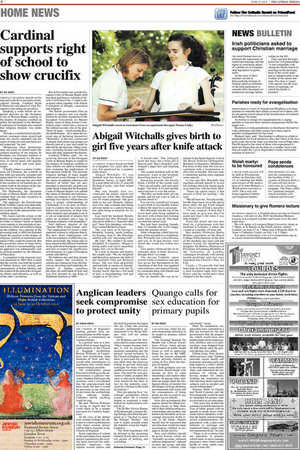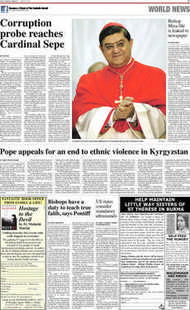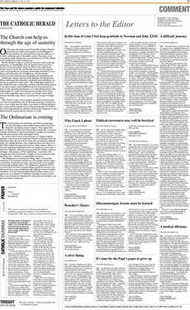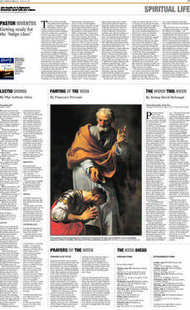Page 2, 25th June 2010
Page 2

Report an error
Noticed an error on this page?If you've noticed an error in this article please click here to report it.
Tags
Share
Related articles
Italy Appeals Crucifix Ban
Court Orders Removal Of Crucifixes From Nursery
Catholic Pupil Resists School's Demand To Remove Tiny...
The Pope Brings Hope To American Church In Wake Of Abuse...
The Catholic Herald
Cardinal supports right of school to show crucifix
BY ED WEST
CHRISTIAN TRADITION should not be rejected in the drive towards a multicultural Europe, Cardinal Keith O’Brien has said ahead of a key European Court ruling on crucifixes.
Speaking a week before an expected decision by the European Court of Human Rights relating to the display of religious symbols in public the president of the Bishops’ Conference of Scotland also warned that religious freedom was under threat.
“Europe is a multicultural and pluralistic continent where church and state are clearly separated and the rights of believers and non-believers are respected,” he said.
“Respecting these distinctions does not mean we should reject the cultural tradition of our nations. In Scotland, our Christian tradition is testified to eloquently by the presence of church spires and steeples across our urban and rural landscapes.
“Clearly, where a country’s traditions are Christian, the symbols of that faith are naturally accepted and appreciated for the contribution that the Christian message has provided to the creation of our present day societies, built on the respect of the dignity of every human person.” On Wednesday the European Court of Human Right will decide whether Italy can ban crucifixes in public buildings.
The applicant, the Finnish-born Soile Tuulikki Lautsi, has taken Italy to court in objection to the presence of crucifixes in the classroom her two children attend.
Mrs Lautsi said the crosses at the Istituto comprensivo statale Vittorino da Feltre in Abano Terme in Padua were contrary to the principle of secularism by which she wished to bring up her children. At a meeting of the governing body in 2001 her husband raised the question of the display of religious symbols in classrooms and asked if they could be removed. But the governors chose to keep them, and a directive recommending such an approach was subsequently sent to all head teachers by the Ministry of Education.
A complaint to the regional court was dismissed in 2005 after it ruled that the crucifix was both the symbol of Italian history and culture, and consequently of Italian identity, and the symbol of the principles of equality, liberty and tolerance, as well as of the state’s secularism But in November last year the European Court of Human Rights held that there had been a violation of Article 2 of Protocol No. 1 (right to education) taken together with Article 9 (freedom of thought, conscience and religion).
The Italian government filed an appeal in January and was legally backed by 10 other signatories to the European Convention on Human Rights, most of them former Communist states which fear a return to the militant secular rule of the past. These 10 states – which include Russia and Romania – have taken the unusual step of declaring themselves “third party” in the case, a term used to denote individuals and groups not directly part of a case who might be affected by the decision. Other countries, including Austria and Poland, have officially supported the Italians.
Cardinal O’Brien said: “As we await the decision of the European Court of Human Rights in regard to the display of religious symbols in state schools we need to remember how sweeping the implications of this decision could be. The precious religious heritage of many people and nations across Europe as well as the values of authentic tolerance and freedom of belief that are propounded in democratic societies are under threat. I hope that the European Court of Human Rights will uphold the values of freedom and tolerance, which are integral to our Christian heritage. In a society which does not have a proper understanding of Christianity it is our duty as Christians to explain that the cross symbolises the generosity of God who offers freedom and salvation to all. It is not an imposition of religion but rather an invitation and a sign of Christian solidarity with all peoples.” Neil Addison, director of the Thomas More Legal Centre, said: “The implications of Lautsi v Italy represent a threat to religious liberty. But how those implications will work out in practice is difficult to say. More profoundly the ruling fails to have regard to the different traditions of the individual European countries and fails to respect the significance of Christianity as a part of European culture and identity.” Mr Addison also said that, despite media reports that crucifixes in schools are a hangover from the Fascist era, the ruling itself stated the obligation to display crucifixes pre-dates the unification of Italy and was first decreed by the King of Piedmont-Sardinia in 1860.
blog comments powered by Disqus





















